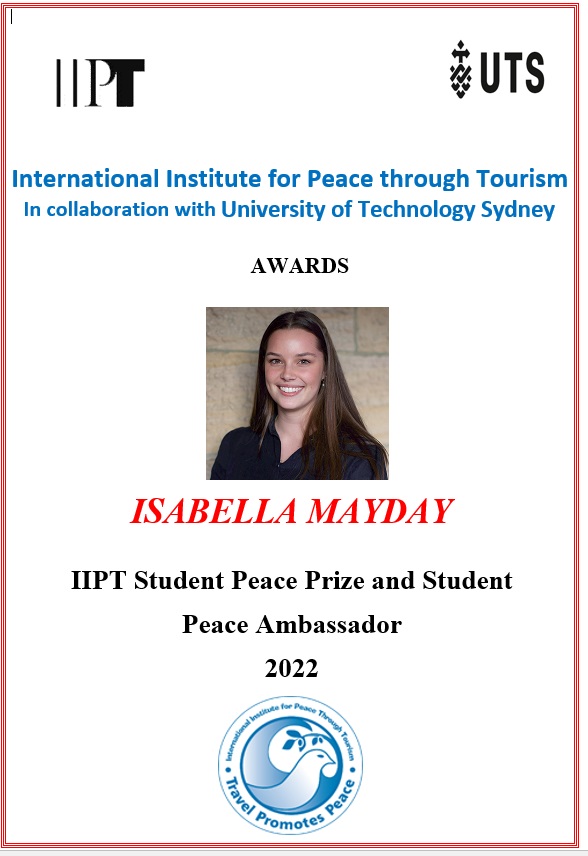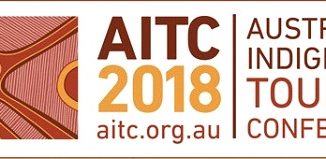With reference to the IIPT Credo of the Peaceful Traveller my reflections on the Challengers and Opportunities in promoting Peace Tourism at a time of upheaval and change in the wider Tourism Industry.
Isabella Mayday – University Technology Sydney, Student 2022

Humanity is presently experiencing and influencing the most profound and rapid paradigm change in human history, with structural inequality having demographic, economic and ecological implications (D’Amore, 2009). We are confronted with numerous challenges, and opportunities post Covid-19 that are global in scope. Meeting the difficulties of these necessitates a change that can be resolved via harmony and peace; however, the adoption of these notions depends on the willingness of the traveller’s. The travel and tourist sector will continue to play a critical and leading role in this change. It will be the fundamental pillar in promoting peace tourism in this time of upheaval and change in the broader tourism industry. Specifically, this idea will be explored through the destination, Hiroshima Japan.
The International Institute of Peace Tourism (IIPT) creates several peace principles and teaches people about the importance of tourism in promoting peace and sustainability in destinations. The IIPT created the ‘IIPT Credo of the Peaceful Traveller’, which is being widely distributed as a beneficial tool for practising the art of peace via tourism (IPPT, 2019). As peace begins with the individual, the CREDO is responsible for the opportunity to travel and experience the world. The concepts outlined in this credo will be utilised in conjunction with research to better balance structural inequalities for individuals in a post-Covid 19 society.
The tourism industry has a virtual role in promoting peace and practising responsible and sustainable activities for the betterment of humankind. However, there is much academic discussion surrounding the willingness and care of global travellers to promote peace actively. Antoniou (2019) suggests that tourists in the post COVID era are less willing to compromise their trips. However, tourism academic Carbone (2020) believes that tourism is expected to focus more heavily on travellers and prioritise human development and peace. Further, Alamineh (2022) found that due to COVID 19, the contribution of tourism to positive peace and sustainable development has significantly been affected positively. Thus tourists are more likely to take on peace and sustainability initiatives when resuming travel. Although it is impossible to know if global travellers actually care, there is a strong potential for developing and sustaining positive peace in Japan.
Transitioning from violence to facilitating global-civic involvement is highly challenging for indivduals to devise (Braniff et al., 2018). The practice of dark tourism is seen through the travel to a destination due to death, misery, or tragedy and is seen as the total opposite of the consumption of pleasant destinations (Meijer, 2015). The IIPT incorporates the notion into their Credo for Peaceful Travel, allowing travellers to visit countries with an “open mind and gentle heart” (IIPT, 2019). Through the opportunity and application of people-centred approaches, dark tourism can focus on the significance of cultural heritage in decreasing disparities and decolonizing heritage practices (Giliberto, 2021). As a result, a learning environment will be created, encouraging travellers to care and engage in open discussions about the importance of promoting peace and Japanese culture. As peace education is infused with tourist policy and practice, awareness of and respect for cultural diversity is fostered via peace tourism.
The memorial sites associated with Hiroshima’s mass dead and nuclear activities make it a particular case for peace tourism and dark tourism. Surprisingly, these attractions are prefaced by peace and cultural heritage rather than war. With over one million tourists expected each year prior to the pandemic, travellers have an intense desire to promote and care for peace tourism (Braniff et al., 2018). However, the link between Hiroshima and Japan’s peace has not been without difficulties. The devastation of the atomic bomb suggests that Japanese society has forgotten its wartime aggressiveness. Higgins (2021) recognizes that encouraging more robust engagement with all stakeholders will generate more excellent dialogue about the meaning and value of tourism and peace. To overcome this challenge, the participation and creation of programs with the local hibakusha (survivors of the bomb) and the local community are essential (Braniff et al., 2018). Further, now that the Hiroshima peace memorial park has become a part of the UNESCO World Heritage site, it serves as a safeguard for eliminating nuclear weapons and promotes world peace, precisely aligning with the ‘open mind and gentle heart’ CREDO. Creating programs to facilitate sustained contact between visitors and residents can foster and promote a culture of peace with the reopening of changes in the tourism industry.
Peace tourism emphasises the idea of positive peace rather than simply avoiding direct violence (Herath, 2016 ). Two significant sectors must function and coordinate to mitigate the negative consequences and promote tourism as a sustainable operation. Host communities should prioritise the quality of service to arriving visitors and be accountable for environmental protection. Secondly, international stakeholders should invest in local initiatives for the gradual growth and reopening of the tourism industry post-Covid-19. Tourism can allow destinations such as Hiroshima that are economically advanced and rich in culture with the ability to encourage others to travel the world in peace. Higgins (2021) emphasises the importance of engaging with local contexts to understand tourism’s peace capacities. Advocacy through social frameworks such as communitybased tourism can motivate travellers to care and promote peace tourism. In particular, community- based tourism can support two critical aspects of the credo: ‘ appreciate all cultures discovered’ and ‘preserve and protect the natural environment which sustains all life’ (IIPT, 2019)
Community-based tourism (CBT) may serve society by restoring social harmony and integration, maintaining cultural legacy, reducing social discontent and restoring peace (Yamashita, 2011). It can be seen as a niche opportunity to promote the credo and reduce inequalities between host communities and travellers. CBT approaches include natural, heritage and cultural attractiveness and therefore are major pull factors for visitors. The local community in Hiroshima offers community development NPO opportunities to make its surroundings and living environment more sustainable (Yuki Tourism Community Development Corporation NPO, 2019). Specifically, adventure tourism is intertwined with their CBT, whereby travellers participate in locally performed tours. Here, tourism can be seen to demonstrate the passion that Japanese people have built in the city and how they live peacefully with nature (Yuki Tourism Community Development Corporation NPO, 2019). As such, residents, tourists, and migrants live in fluid though asymmetrical harmony (Higgins et al., 2021). Further, CBT creates jobs and income, in turn reducing economic inequality. Despite being a popular sustainability strategy among ecotourists, this initiative aligns with the IIPT’s Credo and targets individuals to better align their travel desires towards being conscious and peaceful travellers.
Tourism contributes to world peace and sustainability, including in key international documents. Accordingly, Sustainable Development Goal 16 of the World Tourism Organisation (UNWTO) stresses the need for inclusive, just, and peaceful societies in order to achieve sustainable development (Higgins et al., 2021). Travel restrictions and lockdowns have switched the world from over-tourism to under-tourism, which is beneficial for sustainable development (Tsai, 2022). This phenomenon, however, is not necessarily negative because the decrease in global mobility can be seen as an essential catalyst for sustainable development and focus attention on the value of peace. Thus, the introduction of technology is an inclusive and powerful tool to eliminate the geographical inequality of tourists as well as advocate for peaceful tourism. In this era of social distancing and sustainability, peacemakers have used online communities to drive change (Philips, 2020)
Amid the ongoing and unpredictable Covid pandemic, the tourism industry has been influenced by significant changes and turmoil; thus, individuals have been unable to visit Japan. By partnering with international nongovernmental organisations and Japanese and American artists, the Hiroshima Peace Memorial Museum fostered a virtual tour of the museum while preserving social distancing protocols. (IndyaTv News, 2021). This gives travellers the opportunity to recognize their participation in a sustainability strategy whilst allowing them to reflect on peace initiatives. In particular, Hiroshima’s virtual tourism directly links with peace and therefore upholds the credo principle of “By my spirit, words and actions, encourage others to travel the world in peace’ (IPPT. 2019). Individuals who take part in these tours can share these views and encourage others to travel in peace.
Virtual tourism can provide a temporary but timely solution for potential tourists as the pandemic continues. Based on research, Tsia (2022) formulated virtual tourism as an opportunistic strategy that creates a holistic destination image among prospective tourists. The challenge is that after the pandemic, a significant number of people still may adopt and want to use virtual tourism (Tsia, 2022). Accordingly, the on-site tourism industry will coexist with virtual tourism simultaneously. This means Hiroshima will need to understand how to relate its experiences to in-person and online tourism. Online tourists can actively communicate with online tour guides through live chat functionality, garnering a holistic experience that increases their understanding of the development of a peaceful traveller. Due to the rapid digitization of the world as a result of Covid 19, technology has assisted the tourism revolution by transforming traditional tourism practices, meanwhile acting as a sustainable alternative able to promote peace.
In conclusion, Japan was confronted with numerous challenges, and opportunities post Covid-19. The travel and tourist sector has demonstrated an integral and leading role in advocating peace through tourism. Specifically, dark tourism, community-based tourism, and virtual tourism in Hiroshima can potentially integrate the IIPT’s credo and identify areas in which individuals can use travel as a fundamental pillar in promoting peace tourism and eliminating structural inequality during this time change. Ultimately, in a post covid world, tourists are more willing to care for a harmonious relationship and change their perception towards having a more peaceful travel experience.



